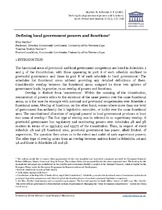| dc.description.abstract | The functional areas of provincial and local government competency are listed in Schedules 4 and 5 of the Constitution, with those appearing in part A of each schedule confined to provincial government and those in part B of each schedule to local government.1 The schedules list functional areas without providing any detailed definitions of them. Considerable overlap between the functional areas assigned to these two spheres of government leads, in practice, to an overlap of powers and functions.
Overlap is distinct from ‘concurrency’. Within the meaning of the Constitution, concurrency of powers refers to the existence of the same powers over the same functional areas, as is the case for example with national and provincial competencies over Schedule 4 functional areas. Overlap of functions, on the other hand, occurs where more than one level of government has authority (be it legislative, executive, or both) over the same functional area. The constitutional allocation of ‘original powers’ to local government produces at least two areas of overlap.2 The first type of overlap can be referred to as supervisory overlap. A provincial government has regulatory and monitoring powers over Schedules 4B and 5B matters in terms of ss 155(6)(a) and 155(7) of the Constitution. Thus, in respect of every Schedule 4B and 5B functional area, provincial government has power, albeit limited, of supervision. The question then arises as to the extent and ambit of such supervisory powers. The other type of overlap arises from an overlap between matters listed in Schedules 4A and 5A and those in Schedules 4B and 5B. In this case, there is no clear definition of the functional areas belonging to each sphere of government, resulting in a lack of clarity about the cut-off points between functional areas. For example, both provincial and local government have authority over health care services, with the only definitional distinction being made through the use of the qualifying term ‘municipal’. Due to this overlap there is a degree of confusion about who does what.
This article is confined to the issues of overlap flowing from the latter type of case. The focus is on the overlap between provincial and local government powers that, unlike the intended concurrent jurisdiction that the national and provincial governments have over Schedule 4 matters, is unintended although not unforeseen.
The aim of this contribution is threefold: (a) to determine the nature and extent of overlap between provincial and local government powers and functions as well as problems flowing from such overlap; (b) to examine how the overlap is being dealt with by stakeholders; and (c) to develop a systematic approach to defining provincial and local government powers. | en_US |

